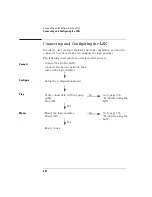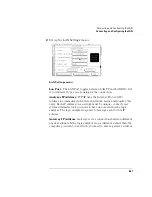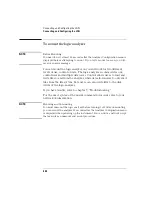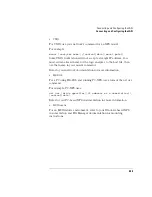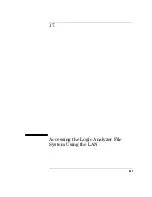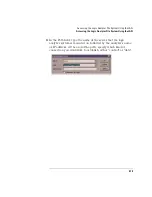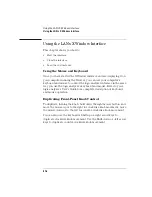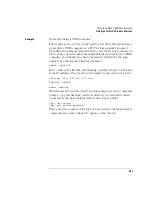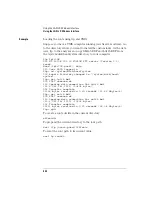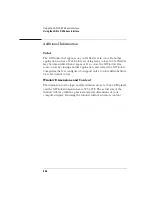
511
Accessing the Logic Analyzer File System Using the LAN
Accessing the Logic Analyzer File System Using the LAN
From Computers Running the MS-DOS Operating System
NOTE:
To use the logic analyzer interface in an MS-DOS environment, you need to
install a program on your PC that allows you to use NFS protocol. One such
program is PC-NFS by SunSoft Inc.
To mount the logic analyzer file system from a PC running MS-DOS,
you must create a logical drive that points to it. A typical MS-DOS
command to do this would look like one of these two examples:
net use [drive name] [host name|IP address]:/
[control|data]
net use [drive name] \\[host name|IP
address]\[control|data]
The choice of drive name is up to you.
The host name of the logic analyzer is set up by your system
administrator. Typically, this name is found in the hosts file on your
computer or returned by a name server. It is equivalent to the logic
analyzer’s IP (Internet Protocol) address.
The control or data option specifies the type of access you want.
Example
Mounting the logic analyzer with MS-DOS
To mount, as the control user, the logic analyzer whose IP address is
"15.6.254.150" to the logical drive "L:", enter the following command at
the MS-DOS prompt. In this example, the PC-NFS application is used.
net use L: 15.6.254.150:/control
After you have entered this command, you will be able to see the
analyzer’s file system under the "L:" logical drive on your computer.
To unmount:
net use L: /d
Summary of Contents for 1670E Series
Page 6: ...6 In This Book...
Page 26: ...26 Contents...
Page 27: ...27 Section 1 Logic Analyzer...
Page 28: ...28...
Page 29: ...29 1 Logic Analyzer Overview...
Page 39: ...39 2 Connecting Peripherals...
Page 49: ...49 3 Using the Logic Analyzer...
Page 72: ...72 Using the Logic Analyzer The Inverse Assembler...
Page 73: ...73 4 Using the Trigger Menu...
Page 101: ...101 5 Using the Oscilloscope...
Page 151: ...151 6 Using the Pattern Generator...
Page 199: ...199 7 Triggering Examples...
Page 237: ...237 8 File Management...
Page 249: ...249 9 Logic Analyzer Reference...
Page 360: ...360 Logic Analyzer Reference The Compare Menu...
Page 361: ...361 10 System Performance Analysis SPA Software...
Page 397: ...397 11 Logic Analyzer Concepts...
Page 430: ...430 Logic Analyzer Concepts The Analyzer Hardware Oscilloscope board theory Oscilloscope board...
Page 439: ...439 12 Troubleshooting the Logic Analyzer...
Page 455: ...455 13 Specifications...
Page 471: ...471 14 Operator s Service...
Page 479: ...479 Operator s Service Troubleshooting Troubleshooting Flowchart 2...
Page 491: ...491 Section 2 LAN...
Page 492: ...492...
Page 493: ...493 15 Introducing the LAN Interface...
Page 497: ...497 16 Connecting and Configuring the LAN...
Page 506: ...506 Connecting and Configuring the LAN Connecting and Configuring the LAN...
Page 507: ...507 17 Accessing the Logic Analyzer File System Using the LAN...
Page 515: ...515 18 Using the LAN s X Window Interface...
Page 527: ...527 19 Retrieving and Restoring Data Using the LAN...
Page 539: ...539 20 Programming the Logic Analyzer Using the LAN...
Page 546: ...546 Programming the Logic Analyzer Using the LAN Programming the Logic Analyzer Using the LAN...
Page 547: ...547 21 LAN Concepts...
Page 555: ...555 22 Troubleshooting the LAN Connection...
Page 580: ...580 Troubleshooting the LAN Connection Getting Service Support...
Page 581: ...581 Section 3 Symbol Utility...
Page 582: ...582...
Page 583: ...583 23 Symbol Utility Introduction...
Page 588: ...588 Symbol Utility Introduction Symbol Utility Introduction...
Page 589: ...589 24 Getting Started with the Symbol Utility...
Page 597: ...597 25 Using the Symbol Utility...
Page 609: ...609 26 Symbol Utility Features and Functions...


